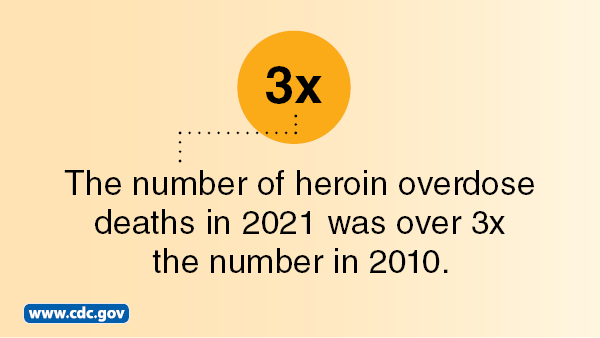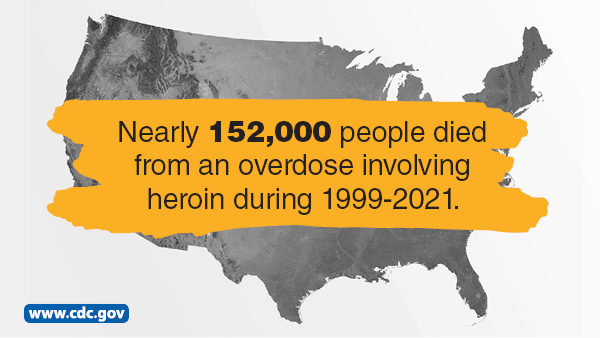
Heroin is a highly addictive, illegal opioid. The seed pods of opium poppy plants make morphine, which is used to create heroin. It is considered highly addictive because all the ways of taking heroin flood the brain very quickly. 1
Over 7% of all opioid overdose deaths in 2022 involved heroin. 2 Not only are people using heroin, but they are also using multiple other substances, including cocaine and prescription opioids. 3

However, from 2021 to 2022, the heroin overdose death rate decreased nearly 36%. 2 Factors that may contribute to the decrease in heroin-involved deaths include fewer people initiating heroin use and, shifts from a heroin-based market to a fentanyl-based market. 45

Heroin is typically injected but is also smoked and snorted. Persons who inject drugs are also at risk of getting a serious, long-term viral infections such as HIV, Hepatitis C, and Hepatitis B, as well as bacterial infections of the skin, bloodstream, and heart (endocarditis).
Repeated use of heroin can lead to tolerance. Opioid tolerance occurs when a person using opioids begins to experience a reduced response to medication or drug, requiring more opioids to experience the same effect. At higher doses over time, the body can experience opioid dependence. If someone who is dependent on heroin stops using it, they can have withdrawal symptoms.
Opioids Use Disorder (OUD) often known as addiction is a problematic pattern of opioid use that causes significant impairment or distress. OUD is considered a medical condition that can affect anyone. Repeated use of heroin can lead to an opioid use disorder. This is more than physical dependence and it is a chronic (long-lasting) brain disorder.
A diagnosis is based on specific criteria such as unsuccessful efforts to cut down or control use, or use resulting in social problems and a failure to fulfill obligations at work, school, or home, among other criteria.
Like many other medical conditions, evidence-based treatments are available for OUD, but seeking treatment remains stigmatized. Stigma can be a major barrier to how well prevention and treatment programs work against the opioid crisis.
A heroin overdose can cause slow and shallow breathing, coma, and death. People often use heroin along with other drugs or alcohol. This practice is especially dangerous because it increases the risk of overdose.
Naloxone is a safe medication that can quickly reverse an overdose from opioids like heroin if it is given in time. It works by blocking the effects of the opioid on the body. Sometimes more than one dose of the medicine is needed. It can restore normal breathing within 2 to 3 minutes in a person whose breath has slowed, or even stopped, as a result of opioid overdose. Naloxone won't harm someone if they're overdosing on drugs other than opioids, so it's always best to use it if you think someone is overdosing.
There are two forms of naloxone, (pre-filled nasal spray and injectable) that anyone can use without medical training or authorization. Naloxone is easy to use and small to carry. People at risk of an overdose are encouraged to carry naloxone with them. They can buy naloxone over the counter at a pharmacy. 6
Treatments for OUD include medicines to treat withdrawal symptoms, medicine to block the effects of opioids, and behavioral treatments.
Opioid addiction treatment can vary depending the patient's individual needs, occur in a variety of settings, take many different forms, and last for varying lengths of time.
Evidence-based approaches to treating OUD include medications sometimes used in combination with behavioral therapy. People getting treatment for OUD can talk to their health care provider to come up with a treatment plan that fits their needs. A recovery plan that includes medication for opioid addiction increases the chance of success. 6